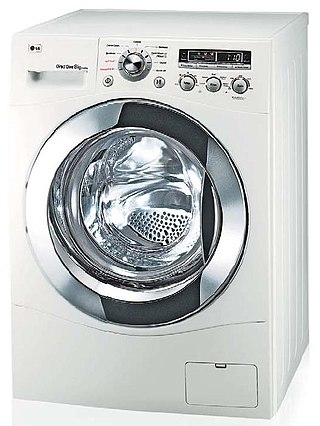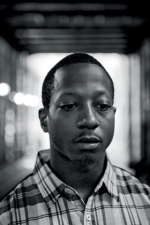
A transistor is a semiconductor device used to amplify or switch electrical signals and power. It is one of the basic building blocks of modern electronics. It is composed of semiconductor material, usually with at least three terminals for connection to an electronic circuit. A voltage or current applied to one pair of the transistor's terminals controls the current through another pair of terminals. Because the controlled (output) power can be higher than the controlling (input) power, a transistor can amplify a signal. Some transistors are packaged individually, but many more in miniature form are found embedded in integrated circuits.
William Harrison Riker was an American political scientist who is prominent for applying game theory and mathematics to political science. He helped to establish University of Rochester as a center of behavioral revolution in political science.

William Thomas "Will" Riker is a fictional character in the Star Trek universe appearing primarily as a main character in Star Trek: The Next Generation, portrayed by Jonathan Frakes. Throughout the series and its accompanying films, he is the Enterprise's first officer, and briefly captain, until he accepts command of the USS Titan at the end of Star Trek: Nemesis. He is the husband of Deanna Troi.

A breadboard, solderless breadboard, or protoboard is a construction base used to build semi-permanent prototypes of electronic circuits. Unlike a perfboard or stripboard, breadboards do not require soldering or destruction of tracks and are hence reusable. For this reason, breadboards are also popular with students and in technological education.

A washing machine is a home appliance used to wash laundry. The term is mostly applied to machines that use water as opposed to dry cleaning or ultrasonic cleaners. The user adds laundry detergent, which is sold in liquid, powder, or dehydrated sheet form, to the wash water.

A periscope is an instrument for observation over, around or through an object, obstacle or condition that prevents direct line-of-sight observation from an observer's current position.

The MacPherson strut is a type of automotive suspension system that uses the top of a telescopic damper as the upper steering pivot. It is widely used in the front suspension of modern vehicles. The name comes from American automotive engineer Earle S. MacPherson, who invented and developed the design.

"The Best of Both Worlds" is the 26th episode of the third season and the first episode of the fourth season of the American science fiction television series Star Trek: The Next Generation. It comprises the 74th and 75th episodes of the series overall. The first part was originally aired on June 18, 1990, and the second on September 24, 1990 in broadcast syndication television.

The Desert Eagle is a gas-operated, semi-automatic pistol known for chambering the .50 Action Express, the largest centerfire cartridge of any magazine-fed, self-loading pistol.

Rikers Island is a 413-acre (167.14-hectare) island in the East River in the Bronx that contains New York City's largest jail.

An O-ring, also known as a packing or a toric joint, is a mechanical gasket in the shape of a torus; it is a loop of elastomer with a round cross-section, designed to be seated in a groove and compressed during assembly between two or more parts, forming a seal at the interface.

Colvin George Scott, better known as Cocoa Tea, is a Jamaican reggae singer and songwriter.

A mixer, depending on the type, also called a hand mixer or stand mixer, is a kitchen device that uses a gear-driven mechanism to rotate a set of "beaters" in a bowl containing the food or liquids to be prepared by mixing them.

Woods Motor Vehicle Company was an American manufacturer of electric automobiles in Chicago, Illinois, between 1899 and 1916. In 1915 they produced the Dual Power with both electric and internal combustion engines which continued until 1918.

A snorkel is a device used for breathing air from above the surface when the wearer's head is face downwards in the water with the mouth and the nose submerged. It may be either separate or integrated into a swimming or diving mask. The integrated version is only suitable for surface snorkeling, while the separate device may also be used for underwater activities such as spearfishing, freediving, finswimming, underwater hockey, underwater rugby and for surface breathing with scuba equipment. A swimmer's snorkel is a tube bent into a shape often resembling the letter "L" or "J", fitted with a mouthpiece at the lower end and constructed of light metal, rubber or plastic. The snorkel may come with a rubber loop or a plastic clip enabling the snorkel to be attached to the outside of the head strap of the diving mask. Although the snorkel may also be secured by tucking the tube between the mask-strap and the head, this alternative strategy can lead to physical discomfort, mask leakage or even snorkel loss.

Biogon is the brand name of Carl Zeiss for a series of photographic camera lenses, first introduced in 1934. Biogons are typically wide-angle lenses.

Riker Anthony Lynch is an American singer and actor. He was previously cast as Jeff, one of the members of the Dalton Academy Warblers singing group, on Fox's television series Glee. He finished in second place on season 20 of Dancing with the Stars with Allison Holker as his dance partner.

Kalief Browder was an African American youth from The Bronx, New York, who was held at the Rikers Island jail complex, without trial, between 2010 and 2013 for allegedly stealing a backpack containing valuables. During his imprisonment, Browder was in solitary confinement for 700 days.
James Emmet Gleason was an American mechanical engineer, President of the Gleason Corporation, and inventor. He was awarded the ASME Medal in 1939.

Scope mounts are used to attach telescopic sights or other types of sights to firearms. The scope sight itself is usually made for only one of two main types of mounts, which can be classified as scopes for ring mounts, for example a 30 mm tube, or scopes for rail mounts, such as the Zeiss rail. Words such as mounts and bases are used somewhat loosely, and can refer to several different parts which are either used together or in place of each other as ways to mount optical sights to firearms.


















